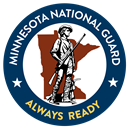Minnesota National Guard, Sept. 11, 2001 to Present
In addition to being called upon for the Global War on Terror, the Minnesota National Guard was called upon to provide stability and peace in the Balkans. Minnesota National Guard troops executed the Bosnia Security Force (SFOR-14) mission 2003-04 and the Kosovo Force (KFOR-5) mission in 2003-04 and again in 2007-08.
The Minnesota National Guard has played a significant role in the war in Iraq. Since 2003, more than 8,000 Minnesota National Guard Citizen-Soldiers and -Airmen have been deployed to Iraq in support of Operation Iraqi Freedom and Operation New Dawn.
Through the professionalism of the Service members and support of their hometown communities, employers, and families, the Minnesota National Guard completed all missions in Iraq with success and honor.
More than 8,000 Minnesota National Guard Citizen-Soldiers and -Airmen deployed to Iraq from 2003 to 2011.
Sixteen Minnesota National Guard Soldiers died in Iraq, and 79 earned Purple Heart Medals due to injuries received in combat.
Sustained military operations in Iraq inspired the Minnesota National Guard to begin the Beyond the Yellow Ribbon program, a ground-breaking process to reintegrate returning Service members back from deployments.
2006 marked the 150th anniversary of the Minnesota National Guard. On April 17, 2006 the House of Representatives of the State of Minnesota congratulated the Minnesota National Guard and honored all the men and women, past and present, who have ever served in the Minnesota National Guard. View the full House Resolution.pdf
The Minnesota National Guard's 1st Brigade Combat Team, 34th Infantry Division, was an important part of the 2007 "surge." As a result of the extension of their tour to 16 months in Iraq, and 22 months overall, the Red Bulls are recognized as having served the second longest tour of duty in Iraq of any military unit, active or reserve.
The Duluth-based 148th Fighter Wing expertly provided real-time surveillance for ground commanders using their Theater Aerial Reconnaissance System.
St. Paul's 34th Combat Aviation Brigade was responsible for corps-level helicopter support from 2008-2009.
In 2009-2010, the 34th Red Bull Infantry Division Headquarters provided command and control for 16,000 U.S. military Service members operating in nine of Iraq's 18 provinces.
With the prevalence of improvised explosive devices on the roadways in Iraq, the St. Paul-based 133rd Airlift Wing provided critical aerial transportation of people, equipment and materiel throughout the region.
In 2011, the 1st Brigade Combat Team mission in Kuwait was the largest deployment of Minnesota Guardsmen since World War II. The brigade's mission included base management, convoy security, reaction forces, and management of specialized units from the Army, Navy and Coast Guard. The brigade drove 1.35 million miles and escorted 25,970 trucks during 480 missions prior to the last U.S. military convoy departing Iraq.
Minnesota National Guard forces are heavily involved in the "Long War" to this day. Current operations have troops deployed for Operation Noble Eagle (Homeland Security) and Operation Enduring Freedom (Afghanistan).
